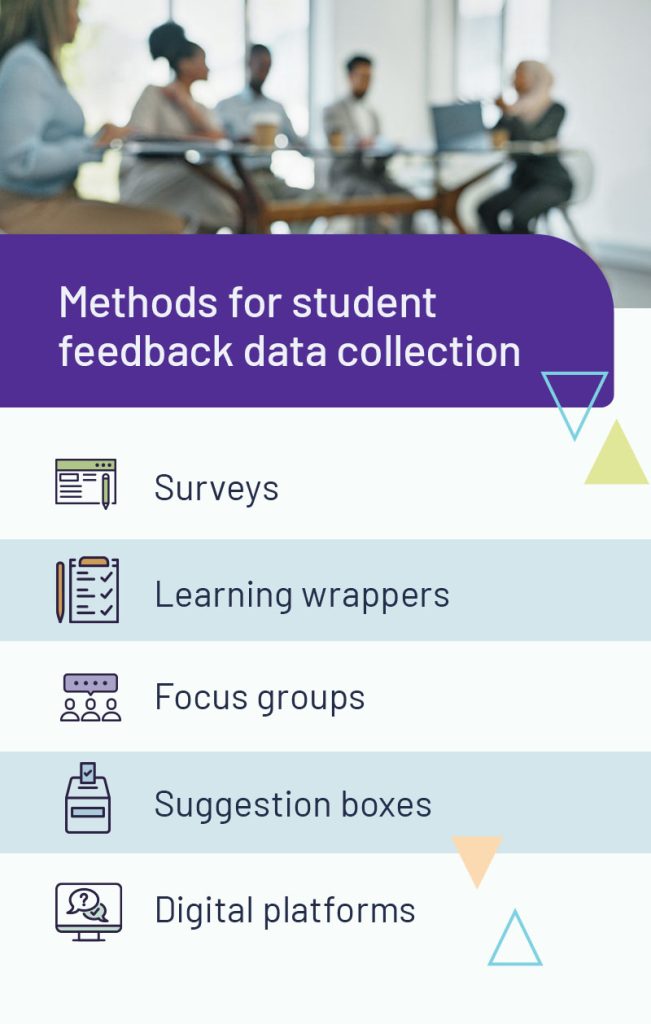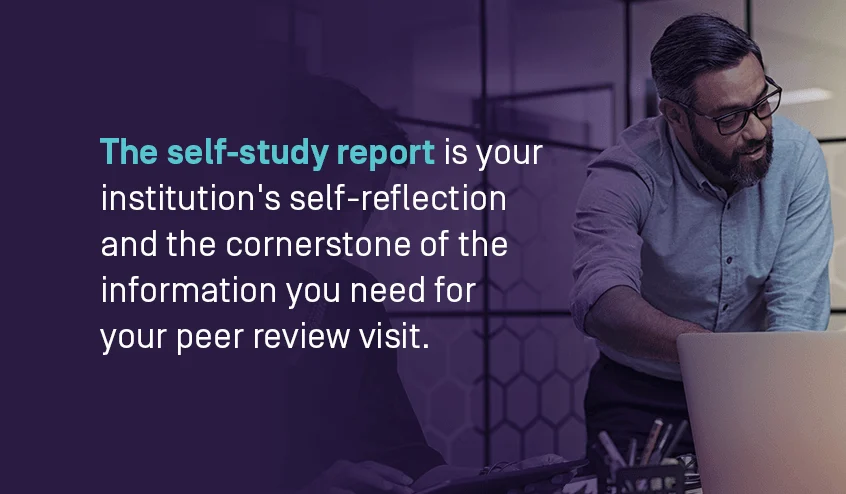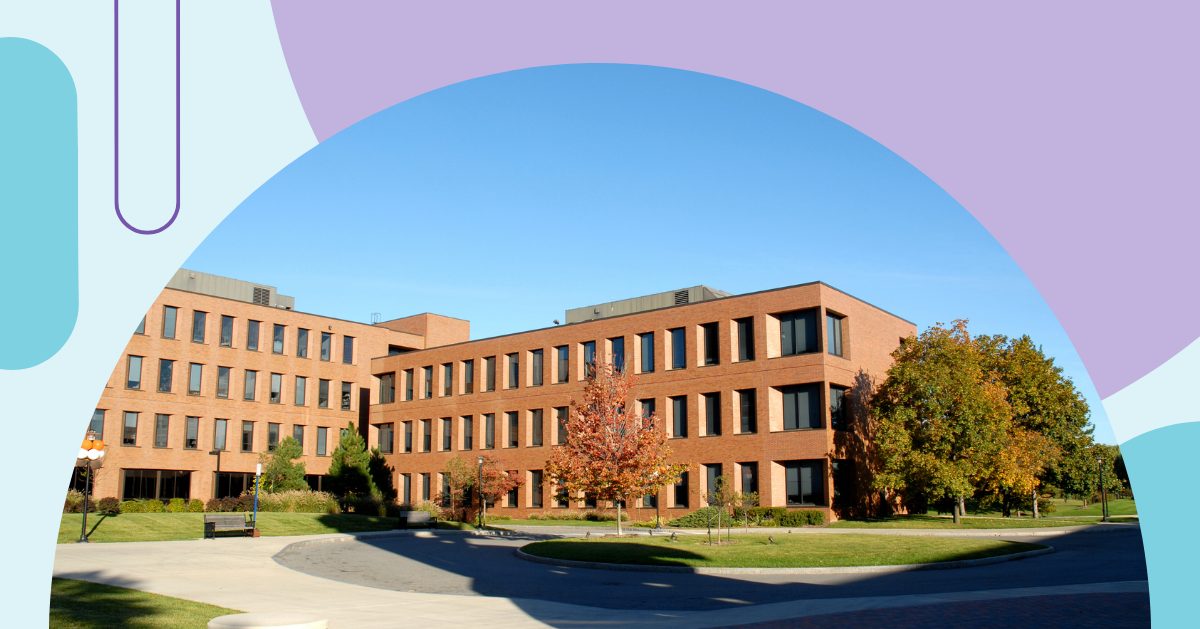
Listening to what students say is one of the most powerful strategies for institutional success. Each student has a unique experience on campus, which can impact their academic outcomes and overall happiness. Their success is your success, so it’s vital to understand their experience and gather their opinions. An effective strategy for prioritizing student feedback is data-driven decision-making.
Learn how to collect and use student feedback to make impactful decisions in this guide. You’ll uncover valuable insights about your student body that can drive change, support students, and help your institution succeed.
Why student feedback matters
Gathering feedback from students and using it to inform decision-making can result in:
- Better teaching: Student feedback can provide insights into teaching effectiveness, revealing how well faculty engage students, convey information, and support their learning. Most importantly, feedback can uncover pain points in the curriculum and campus environment. By addressing issues and employing corrective measures, institutions can improve educational quality.
- Enhanced curriculum development: You can employ course evaluation strategies to learn how students feel about your institution’s curriculum. This feedback can reveal course content students struggle with the most, and which information is irrelevant or outdated. By identifying areas for improvement, you can adjust the curriculum to support students and meet industry standards.
- Increased student engagement: Student engagement refers to how interested and involved students are in their education. Gathering student feedback is a successful strategy for improving student engagement. It gives students a voice and allows them to influence their education and the support they receive, increasing their perception of your institution and helping them become more engaged.
- Improved learning outcomes: Higher education institutions can create a supportive learning environment by improving teaching methods, curriculum content, and support systems. This type of environment can increase the likelihood of student success, reflected in learning outcomes and academic performance.
- Higher retention rates: Students who have the resources to succeed are happier and do better in exams or assessments. High-performing, happy students are less likely to drop out, which results in higher retention and graduation rates. These metrics are imperative for institutional success, as they can help you acquire funding and attract more students.

- Boosted institutional reputation: Many families and students consider academic outcomes before enrolling in a course. Happy students are more likely to excel academically, which reflects positively on your institution. Consistently high academic performance can boost your institution’s reputation, helping to attract students and top faculty.
Methods for student feedback data collection
Regularly checking in with students will allow you to gather feedback data consistently. This strategy helps institutions stay ahead of student concerns and tackle issues before they become overwhelming. Various feedback collection methods exist, and employing a variety of them can yield more comprehensive student insights.

1. Surveys
Surveys are a classic option for collecting student feedback. They’re simple forms containing quantitative and qualitative questions to encourage students to share their experiences. You can send out surveys throughout the year to determine how students feel about course content, campus amenities, teaching methods, and support resources.
The effectiveness of surveys relies on their design and question quality. Ensure your surveys ask specific questions to elicit detailed, honest answers. To improve responses, you can create an environment where students feel safe sharing their opinions to improve responses. Keeping the survey short and giving students time in class to complete it can also improve response rate and quality.
2. Learning wrappers
Learning wrappers are similar to surveys but are typically shorter and made to hand out with assessment results. These forms ask students to reflect on how their study habits and faculty teaching methods affected their performance. This information can help faculty understand the reason for specific grades and determine how to improve student performance next time.
To encourage students to fill them in, explain how it can improve their learning processes and result in teaching method changes. Students are more likely to share their feedback if they feel it will have tangible, beneficial outcomes.
3. Focus groups
Focus groups are a form of group discussion that institutions can use to understand students better. They involve gathering a small group of students and prompting discussion with open-ended questions. Focus groups collect more in-depth feedback from students by allowing you to ask follow-up questions in real time.
The group setting can also make students more comfortable sharing their opinions on a topic, allowing you to collect multiple perspectives. You can follow the discussion as it evolves and let students lead the way. Being flexible and taking a step back often encourages students to share more meaningful feedback and highlight what’s important to them.
4. Suggestion boxes
Some feedback topics can be sensitive, such as those regarding inequality, harassment, or discrimination. Students may hesitate to share their thoughts regarding these topics if their name is attached to their feedback. However, this feedback often has the most impact on institutions, campus culture, and student life.
Provide physical suggestion boxes in quiet areas around campus for students to drop in anonymous notes. Encourage students to use them and emphasize your dedication to addressing and correcting raised issues.
5. Digital platforms
Digitization can significantly improve your institution’s ability to collect impactful student feedback. Smartphone apps, online surveys, digital messaging, and learning management systems are all examples of digital platforms that make gathering feedback quick and easy. You can use these tools to collect feedback from students where they are, whether they’re in a lecture hall, walking around campus, or learning online from home.
Sending surveys directly to student’s smartphones or through learning management systems can increase response rates. You can also utilize digital alerts and reminders to ensure students remember to complete surveys and feedback forms.
Analyzing student feedback
Collecting student feedback is only the first step. To use it to guide decision-making, you’ll need to analyze and interpret the data to uncover key findings. Identifying the most useful information can help you focus your institution’s resources on the right areas and make the biggest impact.
Follow the steps below to analyze your student feedback data correctly.
1. Store and prepare
Data security is a serious concern for students and higher education institutions. When you collect feedback from students, it can contain personal and sensitive information. Ensure you store all feedback in a safe place and educate employees on data security to limit the chance of a breach.
You can start culling your data once it’s safe and secure in a single location. The culling process removes any irrelevant data to ensure you can draw accurate results. Look for issues like duplicate responses, unrelated topics, and incomplete submissions that can skew or corrupt results. Now, you should have a dataset that is relevant to your feedback objectives.
2. Organize
Your data may contain both qualitative and quantitative data to help you better understand students. It’s a good idea to separate the data types to make it easy to analyze them in the next step. You can also organize data according to how you collected it, which courses it involves, or the feedback’s topic. You may also want to organize feedback based on student demographics like age, race, or gender.
3. Analyze
With your data organized into neat categories, you can begin analyzing it. Data analysis aims to transform the data into useful information that’s easily understood. Quantitative analysis — involving numeral data and closed-ended questions — is relatively easy to analyze by employing descriptive statistics. You can find the data’s average, mean, mode, range, deviation, and frequency to make it more digestible.
Qualitative data — which contains words and responses from open-ended questions — is a bit trickier to organize. However, you can use qualitative techniques like thematic coding and sentiment analysis to identify key themes and tones. Thematic coding seeks to identify the key topic or theme of a response, while sentiment analysis identifies the overarching tone or attitude of the response.
4. Find patterns
After analyzing your data, you should have a set of organized, summarized student feedback. The next step is to look for patterns and trends in the data. Doing this will help you identify the most pressing issues and popular suggestions from students. When you focus on these first, you can make more impactful changes that benefit student life.
Use data visualization tools like graphs, charts, and word clouds to make it easier to spot patterns.
5. Extract Insights
Finally, it’s time to find insights that can inform your decision-making. Insights are small nuggets of information that give you a deep understanding of a topic. With student feedback, insights can highlight a critical piece of information that helps you clearly understand the student experience.
For example, you might discover that a student’s grades are slipping because of a lack of motivation. Your institution could set up study groups and encourage students to attend. You could also assign a mentor with similar goals and interests to inspire them and give them a source of guidance and encouragement.
How to put data in the driver’s seat at your institution to help inform decisions and change
Higher education institutions can create real, lasting change by putting data first. Consider the advice below to ensure your data-driven strategy leads to the desired outcomes.
Get faculty and leadership on board
Creating a culture that prioritizes feedback and data-driven decision-making is the key to institutional success. However, asking faculty to change their routines and processes can often be met with resistance. To get faculty on board with this change, you may need to convince your institution’s leadership first.
Higher education leadership — consisting of presidents, deans, provosts, administrators, and department heads — will need to see a strong argument for change. Build your case for data-driven decision-making, focusing on the ease of collecting data and the institutional benefits. Emphasizing its positive effect on resource allocation and student retention can boost your argument.
Report and communicate findings
Once leadership and faculty are on board with data-driven decision-making, you must focus on clear, consistent communication. They will want to have regular updates on your findings and the success of your initiatives.
Start by sharing your initial insights, using graphs and charts to make them easier to understand at a glance. Highlight any areas for improvement, using relevant student feedback to support your claims. Then, provide data-backed recommendations based on your institution’s available resources and goals.
It’s also important to share your wins as you achieve success with your data-driven change initiatives. Doing so can cement the importance of your recommendations and motivate staff to use data for all substantial decisions.
Use insights to inform decisions

Using relevant insights as the basis for decisions is the goal of data-driven strategies. In the beginning, you may need to focus on the quick wins to get leadership buy-in and show students the impact of their feedback. However, your institution can create a plan that involves both short-term and long-term goals for implementing student feedback. Creating a plan at the start can help you prioritize the changes that drive institutional goal progress.
When deciding where to focus change initiatives, consider the severity and quantity of student feedback in these key areas:
- Curriculum design: Use student performance data and feedback to adjust your curriculum to meet their needs. You can identify and adjust topics students struggle with or make changes to ensure the curriculum stays relevant as student interests shift.
- Teaching methods: Data-driven instruction involves using student feedback to improve teaching. While your institution should ensure teaching methods align with industry best practices, adjusting methods according to student needs and preferences can make teaching more effective.
- Campus facilities: Campus facilities support the academic, personal, and social needs of students. Tailoring campus development to student feedback can show students your institution cares about more than just their academic performance.
- Support systems: Student feedback can uncover individuals or groups of students who are struggling financially, academically, mentally, or physically. Prioritize changes that correct severe issues like discrimination, bias, or inaccessibility first. Then, work to add supportive resources like counseling, mentorship initiatives, tutor programs, study groups, workshops, and grants.
Closing the feedback loop with students
Students can become frustrated if they feel your institution doesn’t value their feedback. This can happen even when you are actively working to implement feedback-driven changes but fail to communicate transparently with all stakeholders. To avoid frustration and disengagement, institutions must prioritize closing the feedback loop.
Regarding student feedback, closing the loop refers to the practice of following up with students who have shared feedback. You can do so via website updates, newsletters, emails, or meetings with student representatives. In your communication, share the changes you are planning or have implemented based on their feedback. Thank students for contributing to feedback initiatives, and continue prioritizing their input going forward.
Leverage student feedback data effectively with Watermark

Collecting and assessing student feedback is easy with Watermark. For over 20 years, our software solutions have helped thousands of higher education institutions quickly gather and learn from data. With The Watermark Educational Impact Suite, your institution can put its data into context and discover big-picture insights. We also offer targeted software like Watermark Course Evaluations & Surveys to help you simplify your data collection processes and increase student response rates.
Browse our full software range to see how we can help your institution use data to improve today. When you’re ready to get started, contact us to schedule a demo and talk with one of our reps.















































































































































































































































































































































































































